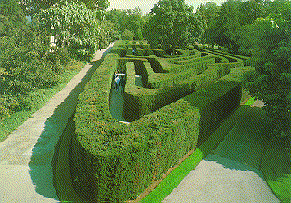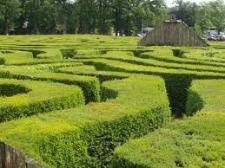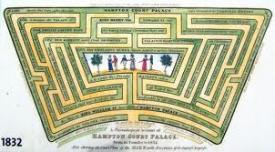
Billie Silvey

During the Middle Ages, garden labyrinths became associated with
love. They were the perfect place for secret assignations.
According to legend Henry II built a labyrinth in his garden at
Woodstock to hide his mistress Rosamund from the jealous Eleanor
of Aquitaine.
By the 17th century, hedge mazes and/or labyrinths were a feature of
nobles' formal gardens as well as of communal gardens. Hedges
could completely conceal a person, be waist high and display statues
within their twisted depths, or merely be turf mazes, lines drawn with
raised chunks of turf.
Church mazes never were popular in England, but turf mazes up to 80
feet in diameter can still be found in or just outside villages across the
countryside. Generally the path is cut about six inches into the ground.
Turf mazes in the UK have survived at Wing, Hilton, Alkborough and
Saffron Walden.
Mazes in Scandinavia were constructed from stone. They may have
been constructed by fishing communities to trap malevolent trolls or
deadly winds.
In 17th century France, King Louis XIV had a labyrinth constructed
as part of the gardens at Versailles. The maze included 39 groups of
statuary representing Aesop's fables. They were plumbed with
hydraulics so the characters emit a stream of water, representing
speech.
Hedge mazes are hard to maintain, and by the late 18th century, most
were being destroyed or allowed to become overgrown. Perhaps the
most famous remaining maze is the Hampton Court maze in England.
It only occupies a quarter of an acre, but is very popular because of
its long history on the site.
Hedge mazes are perfect for parties, enabling guests to mix and
mingle, to have fun and get exercise in nature. Recent mazes similar to
hedge mazes have been constructed of corn stalks in the United
States in the fall.
love. They were the perfect place for secret assignations.
According to legend Henry II built a labyrinth in his garden at
Woodstock to hide his mistress Rosamund from the jealous Eleanor
of Aquitaine.
By the 17th century, hedge mazes and/or labyrinths were a feature of
nobles' formal gardens as well as of communal gardens. Hedges
could completely conceal a person, be waist high and display statues
within their twisted depths, or merely be turf mazes, lines drawn with
raised chunks of turf.
Church mazes never were popular in England, but turf mazes up to 80
feet in diameter can still be found in or just outside villages across the
countryside. Generally the path is cut about six inches into the ground.
Turf mazes in the UK have survived at Wing, Hilton, Alkborough and
Saffron Walden.
Mazes in Scandinavia were constructed from stone. They may have
been constructed by fishing communities to trap malevolent trolls or
deadly winds.
In 17th century France, King Louis XIV had a labyrinth constructed
as part of the gardens at Versailles. The maze included 39 groups of
statuary representing Aesop's fables. They were plumbed with
hydraulics so the characters emit a stream of water, representing
speech.
Hedge mazes are hard to maintain, and by the late 18th century, most
were being destroyed or allowed to become overgrown. Perhaps the
most famous remaining maze is the Hampton Court maze in England.
It only occupies a quarter of an acre, but is very popular because of
its long history on the site.
Hedge mazes are perfect for parties, enabling guests to mix and
mingle, to have fun and get exercise in nature. Recent mazes similar to
hedge mazes have been constructed of corn stalks in the United
States in the fall.
Hedge Mazes




December 2011